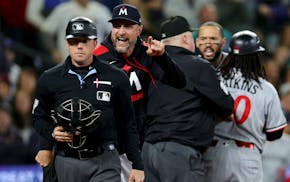Minnesota is planning to notably liberalize the walleye harvest on Mille Lacs Lake starting Aug. 16 under a proposed rule change that would allow a daily bag limit of two fish per licensed angler within a harvest slot of 18 to 20 inches.
State fisheries chief Brad Parsons proposed the move during a meeting Monday of the Mille Lacs Lake Fisheries Advisory Committee in Isle, Minn. It's not official yet, he said, but that's where the Department of Natural Resources is headed.
"It's not a done, done, done deal,'' he said, but Parsons appeared confident that the change will be made.
Since opening day of this year's inland walleye fishing season, Mille Lacs anglers have only been allowed to target walleyes on a catch-and-release basis. The season-long plan — designed to keep the state within its 2024 harvest quota of 91,550 pounds — was to shift on Aug. 16 to a bag limit of one walleye between 21-23 inches.
The idea of loosening the bag limit Aug. 16 to two walleyes within the friendlier harvest slot of 18-20 inches was borne out of missed harvest projections by DNR. At this point of the season, the DNR was expecting to be more than halfway to its safe allowable harvest quota. Instead, the year-to-date harvest stands at only 26% of the total, Parsons said.
Mille Lacs fishing guide Tony Roach, a member of the advisory committee, said the proposed two-walleye bag limit will have an immediate, positive effect on his bookings starting Aug. 16. Another plus for anglers this fall on Mille Lacs will be a change allowing for late-night fishing, potentially starting Sept. 1. DNR plans to announce the changes in an upcoming news release. One aspect of the proposed new rule would allow anglers to keep one walleye of more than 28 inches as part of their two-fish limit.
Parsons said weather and walleye catch rates for the 2024 season didn't play out like fisheries managers were expecting. For starters, meteorologists were predicting a hot, dry summer — a variable that was expected to result in considerable walleye mortality during the catch-and-release season. Those incidental deaths of caught-and-released fish count against the state's harvest quota. When temps are high, the mortality rates spike.
Parsons said DNR correctly predicted a strong walleye bite with high catch rates for the first six weeks of the season. But suddenly — and perhaps because the volume of forage fish surged in the lake — catch rates dropped dramatically in late June and early July, he said. High catch rates would have increased the so-called hooking mortality during the catch-and-release season.
Moreover, DNR assumed fishing pressure would decline 10% year-over-year in 2024. Instead, fishing pressure plunged 25%.
"Fishing pressure has been one-third what we projected," he said.
Several people at the meeting criticized Parsons and his fisheries staff for being too conservative and badly overestimating this year's walleye harvest. The catch-and-release restriction has had a chilling effect on area businesses, they said.
"You guys screwed up," said Steve Johnson, owner of Johnson's Portside Bait & Liquor in Isle.
Parsons said the DNR can't ease walleye catch limits before Aug. 16 because of advance-notification rules that govern the co-management of Mille Lacs shared between the state and eight Ojibwe bands that maintain hunting and fishing rights. The parties meet annually to set a safe allowable harvest limit for long-term conservation.
Parsons told the group he is in favor of longer-range harvest limits that would be set and monitored over a period of years. He also said the DNR needs to set contingency plans at the start of each season that would allow for loosening regulations sooner than mid-August if the walleye harvest is below projections.

Neal: Girma returns to United States national team and rewards fans with her classiness

Twins' Correa ejected from on-deck circle, and he's not really sure why

Twins' inability to score in extra innings costly in wild loss at Seattle

USWNT shuts out China 3-0 at Allianz Field

